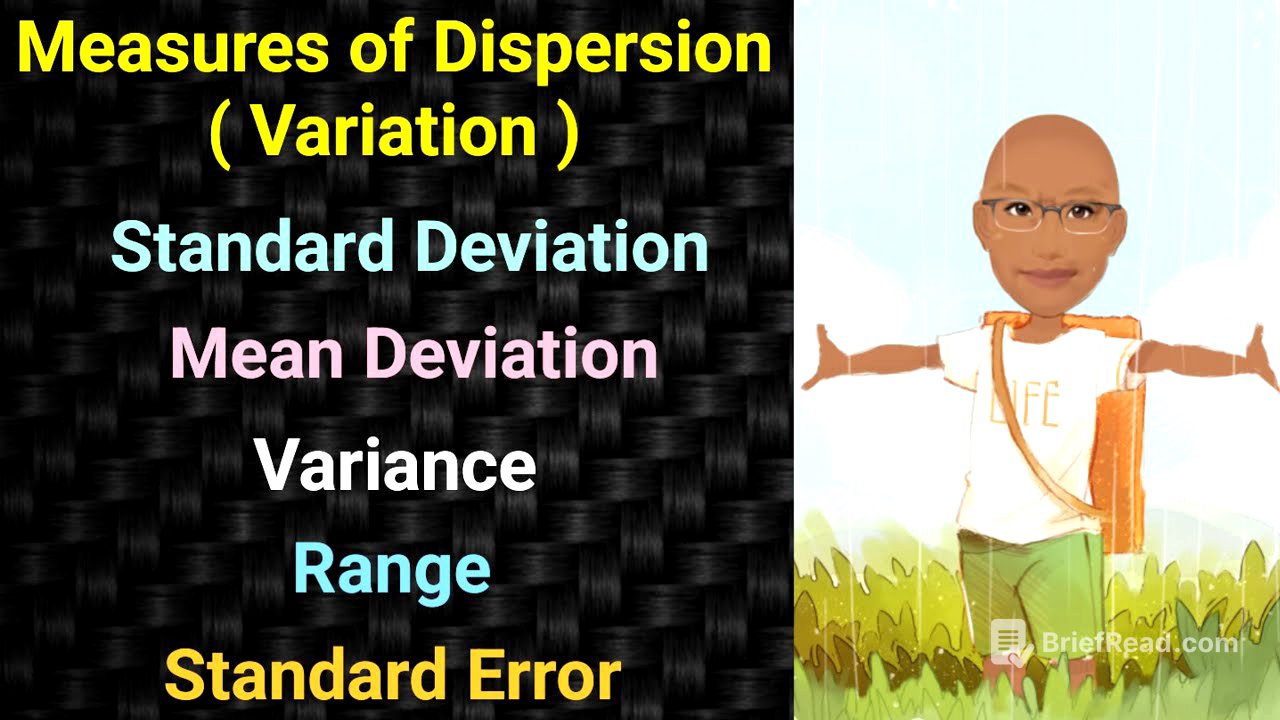TLDR;
This video provides a comprehensive overview of Measures of Dispersion or Variation in statistics. It covers six main measures: range, mean deviation, standard deviation, variance, coefficient of variation, and standard error. The video explains the concepts behind each measure, their formulas, and their significance in statistical analysis, particularly in the context of community medicine and public health. It also addresses the importance of standard deviation, Bessel's correction, and the applications of these measures in various scenarios, including normal and skewed distributions.
- Introduces six measures of dispersion: range, mean deviation, standard deviation, variance, coefficient of variation, and standard error.
- Explains the formulas and applications of each measure.
- Highlights the importance of standard deviation and Bessel's correction.
- Discusses the use of these measures in different types of distributions and sampling.
Introduction to Measures of Dispersion [0:02]
The video introduces the topic of Measures of Dispersion, also known as Measures of Variation, within the broader context of statistics. It references previous topics covered in the channel's statistics playlist, including biostatistics, data types (dependent and independent variables), representation of statistics (bar charts, histograms), and measures of central tendency (mean, median, mode). The presenter emphasizes that understanding dispersion is crucial for analyzing how data fluctuates or varies around a central value.
Understanding Dispersion and Its Measures [1:16]
Dispersion, or variation, refers to how much data points deviate from the average or mean value. The presenter outlines six primary measures to quantify this dispersion: range, mean deviation (or average deviation), standard deviation, variance, coefficient of variation, and standard error. To aid memorization, the presenter suggests grouping these measures into pairs: range and standard error, mean deviation and standard deviation, and variance and coefficient of variation.
Range: Calculating the Spread [5:26]
The range is the simplest measure of dispersion, calculated by finding the difference between the highest and lowest values in a dataset. For example, in an exam with a maximum score of 95 and a minimum score of 5, the range would be 90. While easy to compute, the range provides limited information about the overall distribution of the data.
Mean Deviation: Measuring Average Deviation [6:49]
Mean deviation, also known as average deviation, quantifies how much data deviates from the arithmetic mean. The formula for mean deviation involves summing the absolute differences between each data point (x) and the mean (x̄), then dividing by the sample size (n). The use of the modulus function ensures that all deviations are treated as positive values, providing an absolute measure of deviation. The formula is expressed as: Σ|x - x̄| / n.
Standard Deviation: Root Mean Square Deviation [10:04]
Standard deviation is a crucial measure of dispersion, often referred to as the root mean square deviation. It builds upon the concept of mean deviation by squaring the differences between each data point and the mean, then taking the square root of the average of these squared differences. This process ensures that all values are positive, addressing a limitation of mean deviation. The formula for standard deviation is: √[Σ(x - m)² / n], where 'x' represents each data point, 'm' is the mean, and 'n' is the sample size. The presenter notes that standard deviation can be denoted as SD or sigma (σ).
Sample Size Considerations in Standard Deviation [12:35]
When calculating standard deviation, the sample size (n) plays a critical role. For sample sizes greater than 30, the formula √[Σ(x - m)² / n] is used. However, when the sample size is less than 30, a correction factor is applied, and the formula becomes √[Σ(x - m)² / (n - 1)]. This adjustment, known as Bessel's correction, accounts for the fact that smaller samples tend to underestimate the population standard deviation.
Importance and Applications of Standard Deviation [13:31]
Standard deviation is the most commonly used method for measuring dispersion due to its applicability in both normal and skewed distributions. It provides insights into the distribution of a variable, measures the spread of data, and quantifies the sampling error of the mean variation. The presenter emphasizes that standard deviation is superior to range as a measure of dispersion.
Bessel's Correction: Refining Sample Estimates [18:28]
Bessel's correction is applied when estimating the population standard deviation from a sample. It involves using (n - 1) in the denominator of the standard deviation formula instead of n. This correction reduces bias and provides a more accurate estimate of the population parameter. The presenter illustrates the effect of Bessel's correction with a numerical example, demonstrating how it brings the sample's standard deviation closer to that of the population.
Variance: The Square of Standard Deviation [22:44]
Variance is defined as the square of the standard deviation. Instead of memorizing a separate formula, the presenter suggests simply squaring the standard deviation to obtain the variance. If the standard deviation formula is √[Σ(x - m)² / n], then the variance formula is Σ(x - m)² / n, which is the value inside the square root of the standard deviation formula.
Coefficient of Variation: Comparing Relative Variation [24:29]
The coefficient of variation is used to compare the relative variation between two different datasets or variables. It is expressed as a percentage and calculated by dividing the standard deviation by the mean and multiplying by 100: (Standard Deviation / Mean) * 100. This measure is particularly useful when comparing datasets with different units or scales.
Standard Error: Assessing Sample Accuracy [25:20]
Standard error assesses how accurately the mean of a sample estimates the mean of the entire population. It is based on the normal distribution and is used to determine confidence limits. The standard error of the mean is calculated as the standard deviation of the mean divided by the square root of the sample size: Standard Deviation / √n. The standard error of proportion, used for multiple means, p-values, and confidence intervals, is calculated as √[p(1 - p) / n], where p is the proportion of interest and n is the sample size.
Exam, Viva, and MCQ Tips [27:33]
The presenter offers guidance on how these measures of dispersion are assessed in exams, vivas, and multiple-choice questions (MCQs). In theory exams, short notes on standard deviation are common. Vivas often involve questions on calculating the range, formulas for standard deviation, and the purpose of Bessel's correction. MCQs frequently test understanding of the definitions, formulas, and applications of these measures, including when to use n-1 in standard deviation calculations and the interpretation of standard error.









